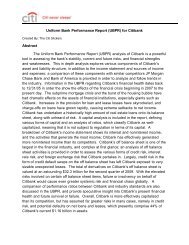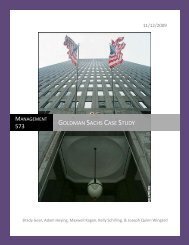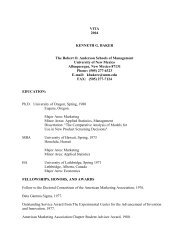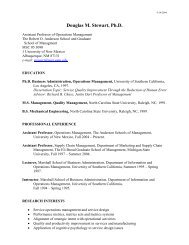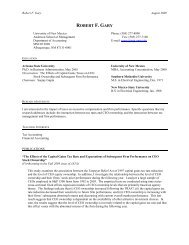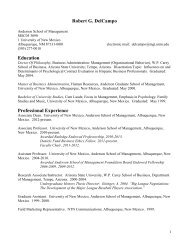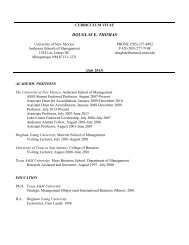Uniform Bank Performance Report - Anderson School of Management
Uniform Bank Performance Report - Anderson School of Management
Uniform Bank Performance Report - Anderson School of Management
You also want an ePaper? Increase the reach of your titles
YUMPU automatically turns print PDFs into web optimized ePapers that Google loves.
and successes. Each component <strong>of</strong> modern banking regulation is the result <strong>of</strong> a lesson learned by<br />
bankers <strong>of</strong> the past. Unfortunately, as was demonstrated by the recent economic crisis, it is still an<br />
evolving and imperfect system.<br />
The five goals <strong>of</strong> banking regulation are what every financial regulatory act is based on. Some <strong>of</strong> the<br />
most important acts attempting to uphold these ideals throughout history have been:<br />
The National Currency Act <strong>of</strong> 1863, which established the charter system for national banks, as<br />
well as created the Office <strong>of</strong> the Comptroller <strong>of</strong> the Currency (OCC).<br />
McFadden Act <strong>of</strong> 1927, which gave states the right to individually regulate the ability <strong>of</strong> banks to<br />
do business within and outside their territories.<br />
The Glass‐Steagall Act <strong>of</strong> 1933, which split the financial services industry into three distinct<br />
entities, commercial banks, investment banks, and insurance institutions. This act was designed<br />
to decrease conflicts <strong>of</strong> interest and encourage the smooth flow <strong>of</strong> markets. It also created the<br />
Federal Deposit Insurance Corporation (FDIC).<br />
The <strong>Bank</strong> Holding Company Act <strong>of</strong> 1956, which limited the scope <strong>of</strong> services a specific type <strong>of</strong><br />
financial entity could provide. This act also introduced the legal concept <strong>of</strong> a “bank holding<br />
company”, which lead to the existence <strong>of</strong> today’s “universal” banking giants such as JPMC.<br />
The Gramm‐Leach‐Bliley Act <strong>of</strong> 1999, which repealed the <strong>Bank</strong> Holding Company Act and<br />
loosened restrictions on banks that prohibited them from owning non‐banking subsidiaries.<br />
And most recently, in 2002, the Sarbanes‐Oxley Act, which required public accountants to audit<br />
financial institutions. This act was created in response to problems <strong>of</strong> corruption and accounting<br />
fraud within financial institutions.<br />
Regulation <strong>of</strong> JPMorgan Chase & Co.<br />
After the repeal <strong>of</strong> the Glass‐Steagall Act by the Gramm‐Leach‐Bliley Act, JP Morgan & Co. was able to<br />
acquire Chase <strong>Bank</strong>, creating what is now known as JP Morgan Chase & Co. Holding Company. Prior to<br />
this, JPMorgan & Co. was simply a commercial bank, operating under the regulations set out by the<br />
Glass‐Steagall Act. Now that it was a Financial Holding company it could branch its operations into new<br />
lines <strong>of</strong> financial services such as: Insurance underwriting, securities dealing and underwriting, financial<br />
and investment advisory services, merchant banking, issuing or selling securitized interests in bank‐





